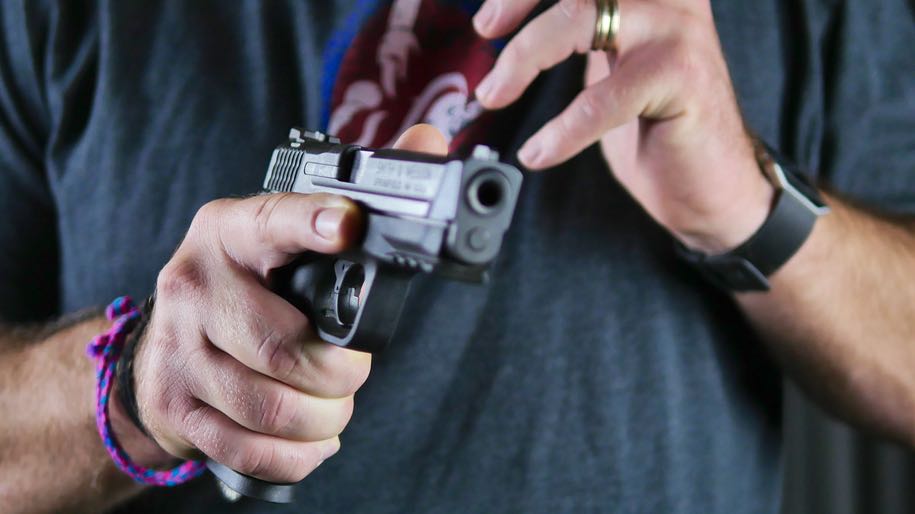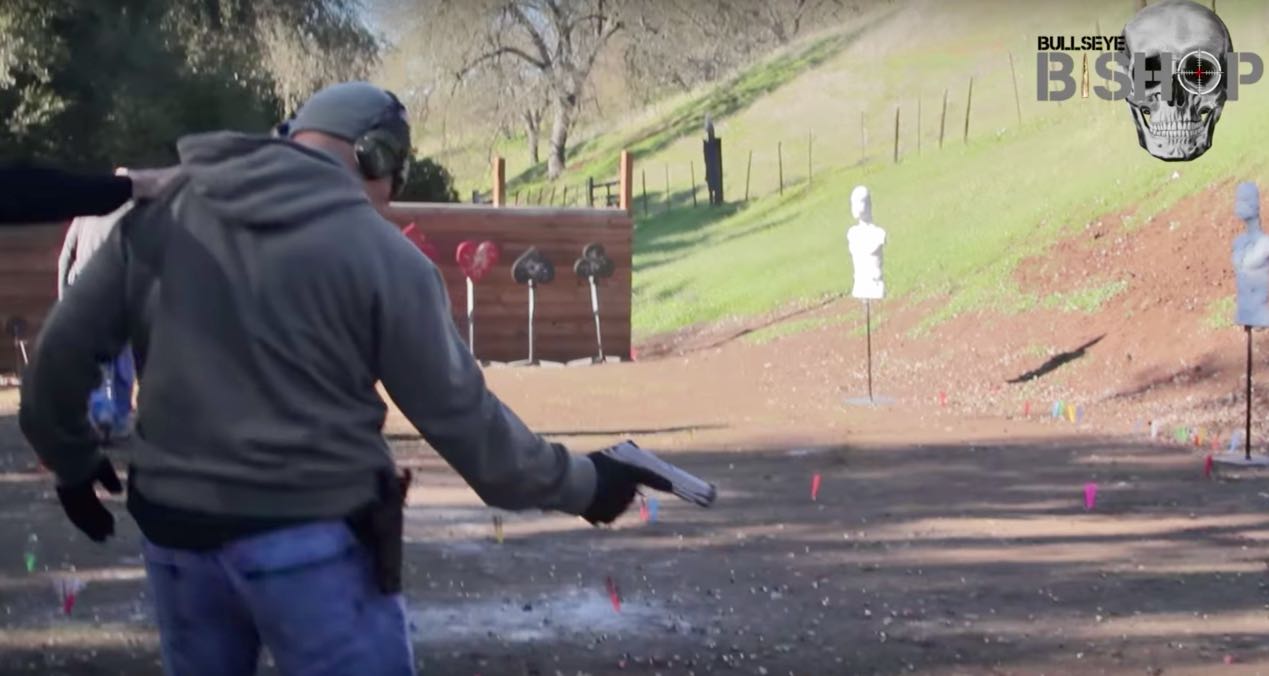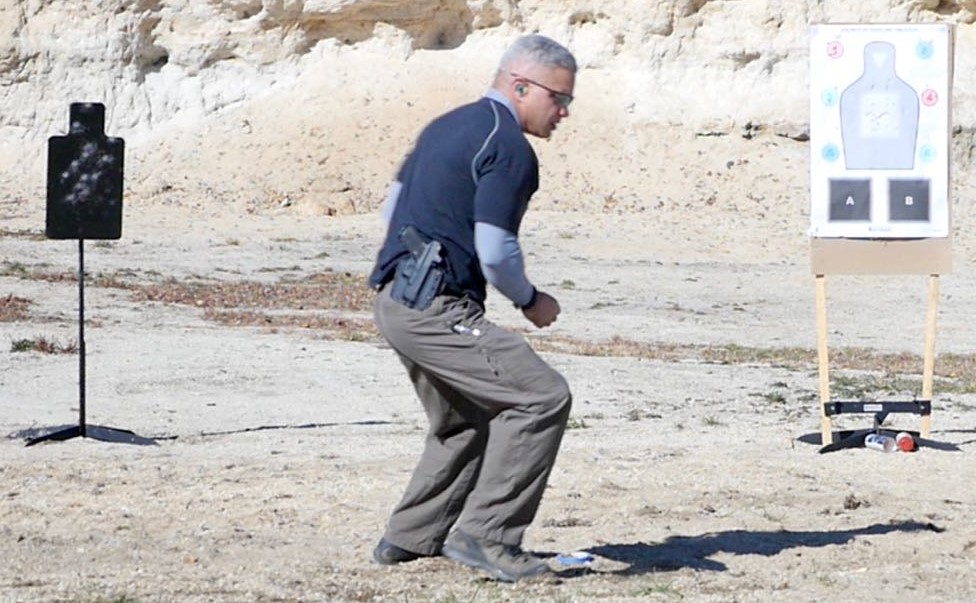
Keep your finger someplace other than the trigger until you are ready to shoot. This is a fundamental gun safety rule that needs to be followed.
Photo: author

A competent instructor constantly assesses the situation. In this screenshot from the video, the shooter’s body language demonstrates his confusion and is cause enough alone to stop the exercise.
www.personaldefensenetwork.comSAFETY IS THE RESPONSIBILITY OF THE INSTRUCTOR
In the video, the student’s actions (as incorrect as they are) are not what bother me the most. Instead, it is the actions of the instructor that have me concerned. Remember, safety is the responsibility of the instructor. Before any training exercise begins (I use that term generally, not necessarily in reference to this video), it is the duty of the instructor to determine if the benefits they believe the students will gain from the exercise are worth the risks involved. There are always risks. From a twisted ankle to a gunshot wound, risks are always there. The question is, are the benefits worth taking the risks? An experienced instructor who considers safety wisely looks at it from multiple angles.- What are the gains that the student will take away?
- If a risk becomes reality, how severe will the consequences be?
- How likely are the risks to actually happen based on the circumstances?

Dynamic training is not inherently dangerous. One important way to make training safe is to constantly evaluate to ensure the benefits significantly outweigh the risks. Photo: author
www.personaldefensenetwork.comTHE RESULTS OF MULTIPLE SAFETY ISSUES
Let’s take a look at the reasons for the serious safety issues in this video and the ways they could have been averted. Before the ND, it is clear that a safety violation of some kind is likely to happen. The student’s hips and shoulders aren’t square to the target. A safe draw can certainly be accomplished when you aren’t squared up to your target, but most people need to be taught to draw safely in this type of orientation. This is an error on the instructor’s part. Failing to teach your student the techniques required to safely perform a task is asking for trouble. This isn’t a time to assume your students know what to do and how to do it. A quality instructor assesses the skill level of the student before asking the student to perform tasks that have additional risks associated with them. The student, who is intending to establish a two-handed grip, negligently fires the gun before the weak hand meets the strong hand. This is a clear indication that the finger was on the trigger before the student was prepared to shoot. This is a violation of fundamental gun safety rules. My guess is, this was not the first time his trigger finger was placed on the trigger before the decision to shoot was made. This is an error on the instructor’s part for not appropriately addressing this important issue prior to this situation. It is an additional failure to commence a complex drill when your student has a fundamental safety issue. When asked to execute multiple tasks simultaneously, students who have a history of making safety errors can be expected to make additional safety errors. It is irresponsible to allow a student to participate in a drill they are unlikely to complete safely. I saved the best for last. After the negligent discharge (and multiple negligent instructor decisions related to safety), the student is not only allowed to continue the drill, but encouraged to do so. The instructor can be heard saying, “You’re good, you’re good!” just after the errant report. This is most disturbing, and at the same time sums it all up. This student at this moment is anything but good. At a minimum, the student is negligent for firing his gun when he did not intend to fire the gun, but the situation could be much worse than that. You can clearly see the student’s surprise and confusion. The last thing this instructor should have this student do, now with a certain history of safety issues, is continue with the “training.” The confusion, anxiety, and other emotions this student is now experiencing are not going to enhance the student’s ability to complete the drill safely. This third and most irresponsible failure again rests firmly on the instructor.
Defensive training can be complex and safe at the same time. Providing students with the foundation to correctly and safely perform training activities is taken seriously by quality instructors. Photo: author
www.personaldefensenetwork.com
Sorry........but I do not identify with that type of firearm instruction. I would not have anyone grabbing me and pushing me along..........especially firing a weapon. I need to learn to function on my own........where I will be in a real defensive situation. If this instructional technique was judged "necessary"-- then I would suggest that these students were being progressed too fast. The goal of Instruction is to produce independent competency and not encourage or exploit dependency. I have had many fine instructors who model this approach. I can appreciate that, with the recent elevated interest in self defense training, there are many new users who are coming to the business without prior training.........I am sure our Instructional cadre can devise a safe and more dignified method.
When my grown boys were just small boys play in Cowboys and Indians I started teaching them finger discipline. I also started teaching them to point their toy weapons down the ground until they were ready to shoot the Indian or the cowboy etc etc. As they grew older we went to a 22 rifle and a 22 pistol in learning how to handle a firearm. Eventually they bought their own rifles shotguns and pistols. So naturally I had to build a range behind the house so that we would have a place to continue to be safe. Rules of the house were no weapons loaded in the house. Certainly nothing chambered. Boys being boys small or large one of them forgot one of the rules of the house coming down the stairs his shotgun went off. $950 window had a whole image. God was good we live in the middle of four and a half acres of woods the trees outside the house called the blast. The neighbors didn't even hear it. All the trees absorbed the noise. That was an expensive lesson for him house rules and the four safety rules. But it was a lesson he will never forget as long as he's alive.
As always - great article and reading. Good lesson for Instructors. If you never followed the words written here - you should start doing it now. ;-)
Good advice BUT i prefer to teach finger off the trigger, STRAIGHT ALONG THE FRAME, until you have identified your target AND decided to fire. this allows the instructor a clear view of the trigger finger in most cases and gives the student a specific training objective to do the same thing the same way each time.
none
Been around firearms many years & practice safety rules diligently all my life. Past these rules to both my kids , so well back about twenty years ago I was alone cleaning one of my S&W 659 at the coffee table & then realized I couldn’t take the slide off the frame. , upon investigation to my horror I found I had left a round in the chamber. I wasn’t clearly focused on the task at hand. For a moment I let my train of thought get distracted & the result could have been disastrous. I kept saying to myself “Dumb€SA”.
training location near Tampa Fl
Read the article and all the responses. Outstanding text and contributions by the readers! Everything here is right on target — so thank you to everyone!! With my lifetime of FA training and experiences, I solidly concur with emphasis on safety, Instructor responsibility, and the trainee or learner role as a willing and mature student! Which has immense emphasis in individual responsibility — of everyone involved. My final comments, besides thanks for the great article, is: “Think at every level, remain aware at all times, obey the Instructor instantly, practice on a regular schedule or as often as possible, and work work work on your own FA skills!”
No recommendation of wearing body armor? Why not? If you are serious about safety... wear body armor, at a training range. Duh?
This should be read by every instructor in my opinion. It hits the nail on the head as far to often, it is forgotten that Safety is our first priority. Yes, we all like teaching people great things they can accomplish with a defensive pistol, but never at the chance of injury. Our job is to ensure a student can perform the task safely and if not, then to communicate and build "their weakness". Each person is different and the need to constantly be aware of the level of each student. We need to be able to break down the "task at hand" and ensure they meet a "standard" that is one safe and two competent, if not doing that they we are not giving our students what they truly need, and providing unjust training. No one but a good Instructor know's the amount of stress that comes with not only ensuring students learn a skill, but how much effort it takes to ensure it is done safely. We (Instructors) have an obligation to the student, their families and the community overall.